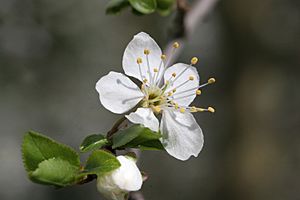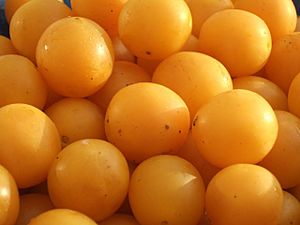Mirabelle plum facts for kids
Quick facts for kids Mirabelle plum |
|
|---|---|
 |
|
| Blossom of Mirabelle plum in detail | |
| Scientific classification | |
| Kingdom: | |
| (unranked): | |
| (unranked): | |
| (unranked): | |
| Order: | |
| Family: | |
| Genus: | |
| Subgenus: |
Prunus
|
| Section: |
Prunus
|
| Species: | |
| Subspecies: |
P. domestica subsp. syriaca
|
| Trinomial name | |
| Prunus domestica subsp. syriaca |
|
The Mirabelle plum (Prunus domestica subsp. syriaca) is a special type of plum tree. It is thought that this sweet fruit first grew in a wild form in a place called Anatolia, which is part of modern-day Turkey.
Contents
What is a Mirabelle Plum?
Mirabelle plums are easy to spot! They are small and oval-shaped. Their skin is smooth and can be red or a dark yellow. Often, they have little flecks or spots on them.
These plums are famous for being very sweet and full of flavor. People use them in many ways. They are great for making jams and dessert pies. Their juice can also be turned into wine or a plum brandy.
About 90% of all Mirabelle plums grown for sale become either jam (70%) or a special plum drink called eau de vie (20%). But don't forget, they are also super tasty to eat fresh!
Harvesting Mirabelle Plums
Mirabelle plums are ready to pick from July to mid-September in the Northern Hemisphere. Farmers used to shake the trees by hand to get the ripe fruit to fall. Now, machines do this job. But the idea is still the same: the ripe plums are gently shaken off the tree and collected in a big net underneath.
Types of Mirabelle Plums
There are a few different kinds of Mirabelle plums. The most well-known ones are:
- Mirabelle de Nancy
- Mirabelle de Metz
Mirabelle de Lorraine
The Mirabelle plum is a very special fruit from the French region of Lorraine. This area has the perfect weather and soil for growing these plums. Lorraine produces about 15,000 tons of Mirabelle plums every year. That's about 80% of all the Mirabelle plums grown for sale around the world!
The two main types grown in Lorraine are the Nancy type and the Metz type.
- The Metz type is smaller, a bit softer, and not as sweet. It doesn't have red spots on its skin. It's great for making jam.
- The Nancy type is sweeter and better for eating fresh.
Since 1996, the "Mirabelle de Lorraine" has a special label from the European Union. This label is called a Protected Geographical Indication (PGI). It means the plums must be a certain size (at least 22 mm) and have enough sugar. This label also guarantees they come from a specific area in Lorraine.
Mirabelle Festival
The city of Metz in Lorraine celebrates the Mirabelle plum with a big festival in August. It lasts for two weeks! At the festival, you can find fresh plums, Mirabelle tarts, and Mirabelle liquor at open markets. There's also live music, fireworks, parties, art shows, and a parade with beautiful floats. A Mirabelle Queen is even crowned during a special gala!
Where Else Do Mirabelle Plums Grow?
Mirabelle plums are also very popular in Germany. They grow both wild and on farms, especially in the south and southwest parts of the country. People in Germany enjoy them fresh or use them to make cakes, liquor, jams, and canned fruit.
In Spain, you can find them in Galicia, especially in the O Rosal valley. They were brought there in the mid-1900s and have grown very well. In Galicia, people eat them fresh or make jams and liqueurs. They also grow wild near rivers and roads in the Ebro Valley in parts of Zaragoza, Teruel, Lleida, and Tarragona. In Aragon, these plums are sometimes called cascabeles.
In England, Mirabelles grow wild and on farms in places like Essex and Hampshire. You can find yellow, orange, and red kinds. There's even a very old hedge in Sheringham, Norfolk, that has red, yellow, and orange varieties. The Metz type grows wild in Suffolk. You might also find a few trees in Liverpool, Milton Keynes, and near Northampton. In 2015, a single tree in Hucknall, Nottinghamshire, produced a huge amount of fruit! They are also found in hedgerows in Sutton-on-Trent, Nottinghamshire, and on a golf course in Lincolnshire.
Mirabelle plums are also common in the Czech Republic, Hungary, Romania, Bosnia-Herzegovina, Poland, Slovakia, and Slovenia. They grow wild and on farms, often along roadsides. In the United States, some Mirabelle trees planted in the 1940s are still producing fruit in neighborhoods in Tamalpais Valley, just north of San Francisco.
Protecting Mirabelle Plums
It is generally difficult to bring Mirabelle plums into the United States. This is often done to protect local plants from diseases or pests that might come with imported fruits.
See also
 In Spanish: Mirabel para niños
In Spanish: Mirabel para niños




